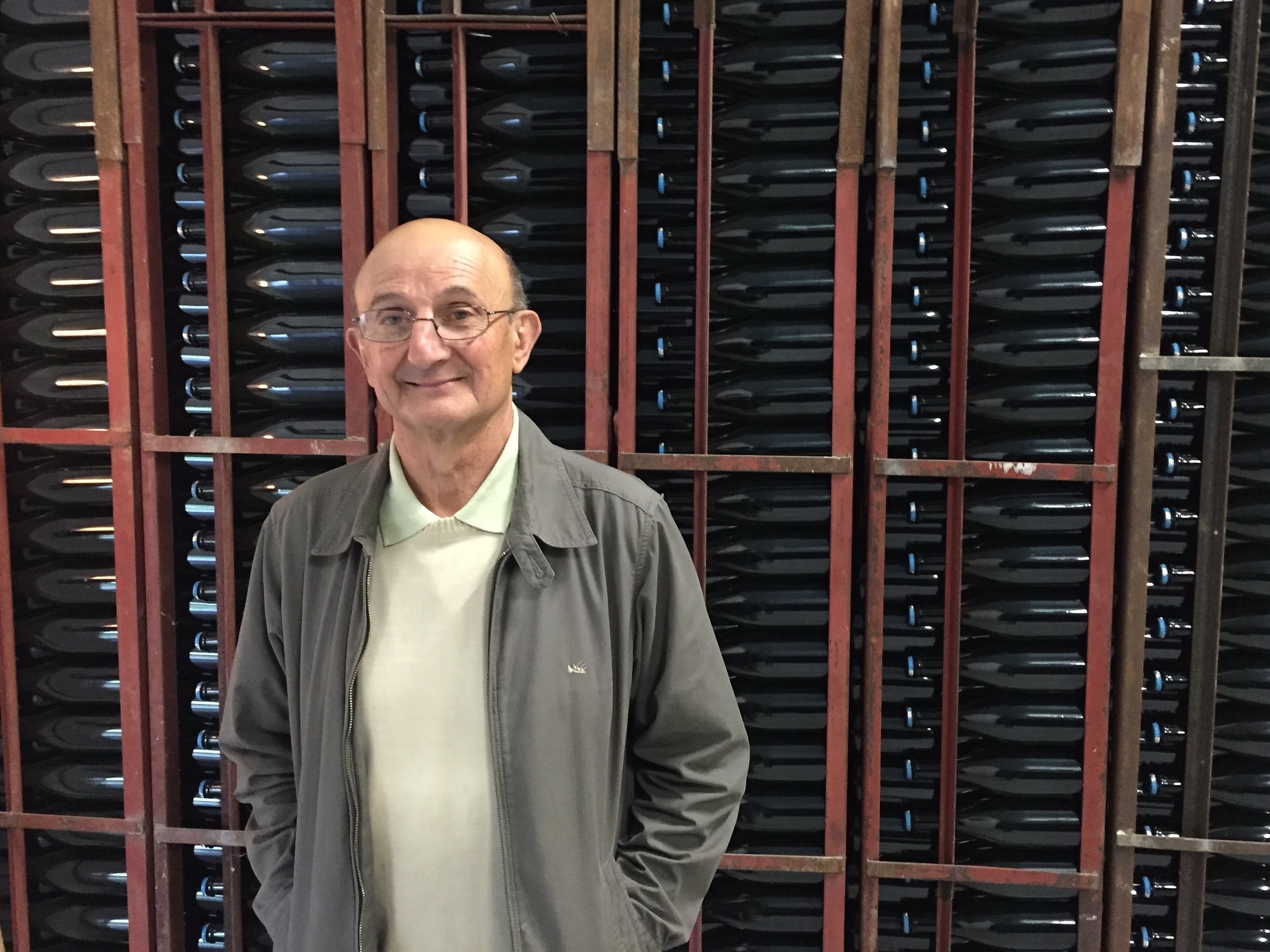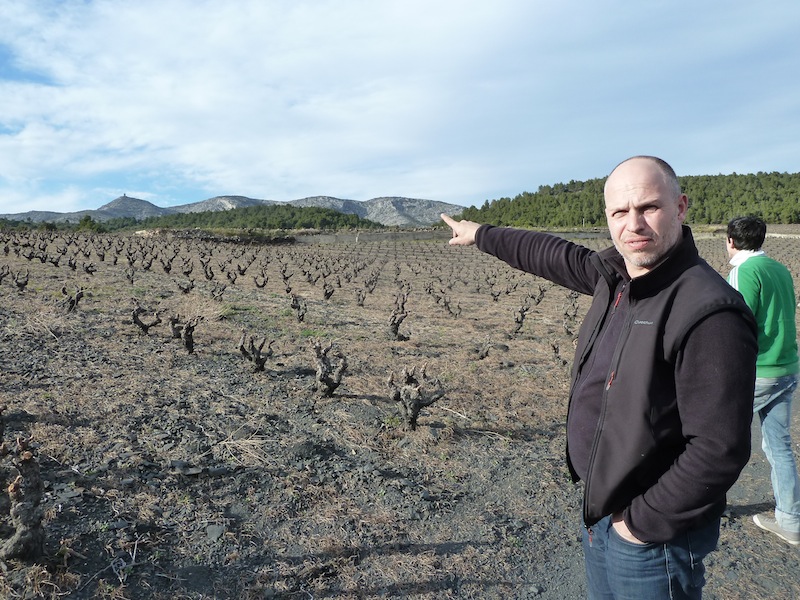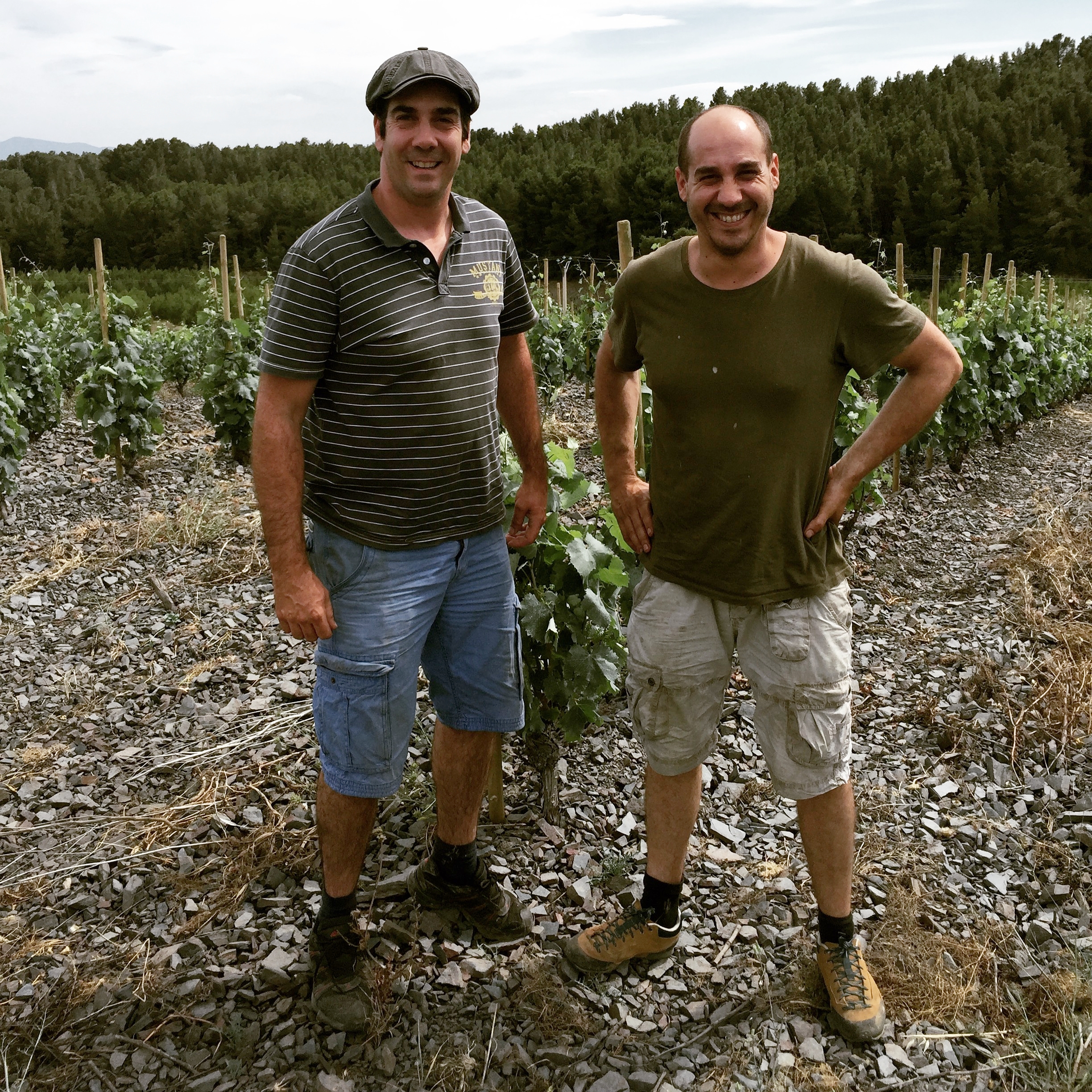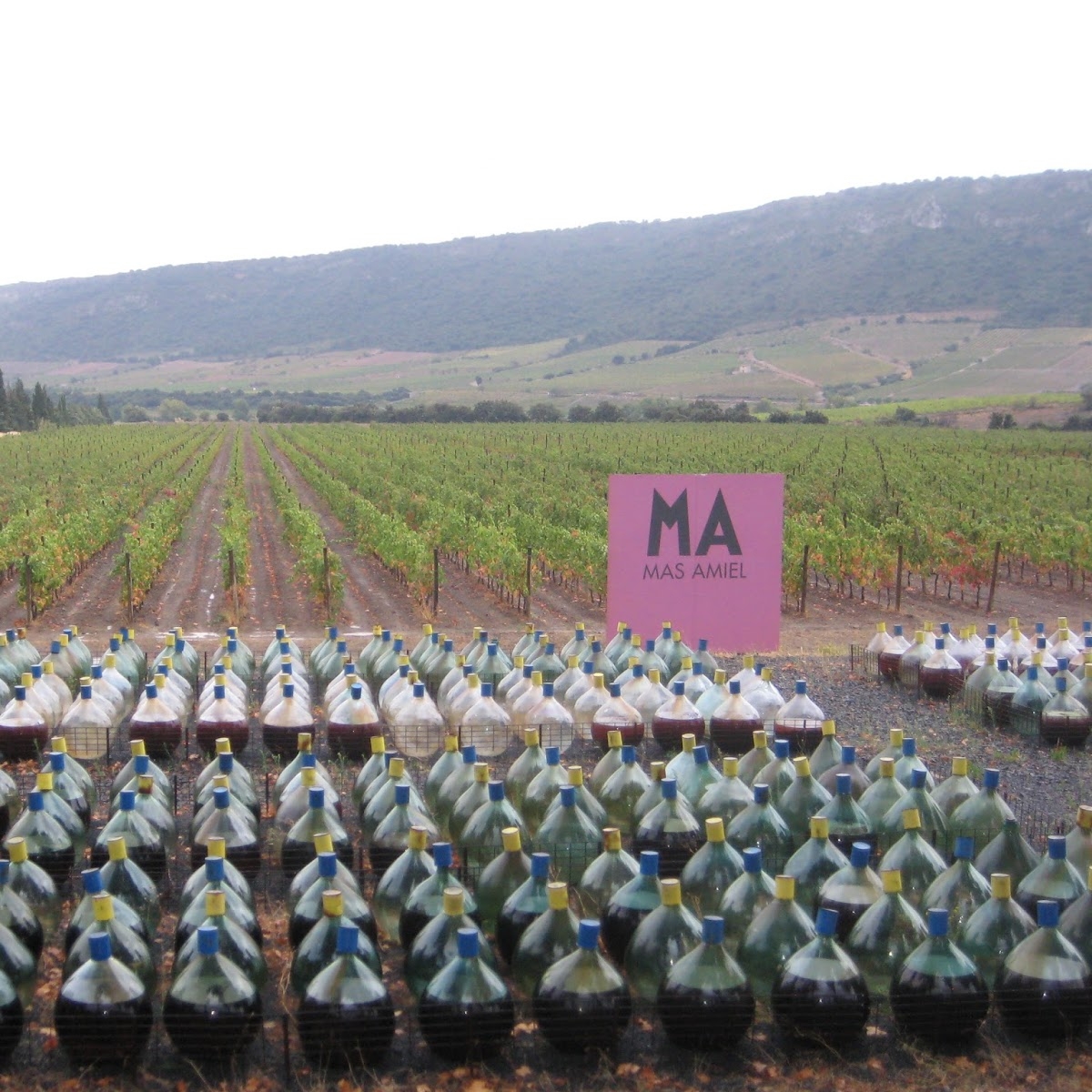LANGUEDOC - ROUSSILLON
LANGUEDOC - ROUSSILLON
DOMAINE DE RAPATEL - G.EYRAUD
DOMAINE DE L’HORTUS - JEAN ORLIAC (PIC SAINT LOUP)
DOMAINE J. LAURENS (LIMOUX)
WINE BY JEFF CARREL (CORBIÈRES)
DOMAINE DANJOU-BANESSY (ESPIRA-DE-L’AGLY)
MAS AMIEL (MAURY)
DOMAINE INEBRIATI (VACQUIÈRES)
DOMAINE DE RAPATEL - G.EYRAUD
MINIMAL INTERVENTION
—
Read More...
Situated in the area of the Costières de Nîmes between the ancient cities of Nîmes and Arles, and at the Camargue National Park gates, is Domaine de Rapatel, run by the eccentric and winsome Gérard Eyraud.
Le Domaine de Rapatel originated in 1905 by Gérard's grandfather, Louis Guiot, who made wine and raised lamb on the farmland of an ancient monastery. Louis decided to keep the monastery’s name, Rapatel, for his domain, which means ‘warm sun’ in the Catalan language.
In the late 1960s, Gérard's father Pierre Eyraud took the reins of domain, selling the grapes to cooperatives and installing a market garden. Gérard inherited the property in 1979. His passion for natural farming led him to let the soil and grapes rest without the use of chemicals for ten years before making his first vintage. He’s been crafting complex, expressive natural wines ever since.
Rapatel’s 30 hectares of grapes are bathed in permanent sunlight and receive the cold, northwesterly Mistral wind all year round. Sandstone, limestone-rich clay, and large pebbles comprise the soil structure, and no pesticides or chemical fertilisers are used on the vines. Only organic solutions are used to prevent and cure the vines, like nettle manure, ewe whey, and horsetail decoction.
Gérard farms 27 hectares of red varietals, including Grenache, Syrah, Carignan, Cinsault, Mourvèdre, Cabernet, Merlot, and Marselan; and three hectares of white Roussane, Bourboulenc, and Chasan. Grapes are harvested manually when at their absolute ripest, and each plot is processed separately using natural yeasts. Gérard’s wines are not filtered or fined, and contain no added sulphur and see no oak. This passionate vigneron allows his wines to ferment and evolve in fibreglass or concrete tanks for three to five years before being bottled.
Labels and classifications are not Gérard’s style, rather his wines are a union of pure grapes and passion. His colourful, distinct wines are demonstrative of his perpetual quest for excellence.
His raison d'etre can be summed up in this quote from him: "Rapatel is what I really am, what I like to do and what I want to share with people and wine lovers. Being fashionable? No way! I’m not running a coca-cola factory. I produce exactly what I want to."
DOMAINE DE L’HORTUS - JEAN ORLIAC (PIC SAINT LOUP)
—
2021 IGP Val de Montferrand "La Bergerie" Blanc (Chardonnay blend)
2020 AOC Pic Saint Loup "La Bergerie" Rosé (SGM)
2020 AOC Pic Saint Loup "La Bergerie" Rouge (SGM)
2020 AOC Pic Saint Loup "Grande Cuvée" Rouge (SGM)
Read More...
Located in a valley between the two dazzling limestone cliffs of Pic Saint Loup and Montagne de l’Hortus, this almost-40-year-old vineyard produces highly drinkable wines indicative of the finesse and personality that forms them.
The domain is a 24-kilometre drive north of Montpellier, located among the cooler plots of the Pic Saint Loup AOC—which was granted appellation classification in February 2017, and is a sub-zone of the Languedoc AOC.
Vigneron Jean Orliac and wife Marie-Thérèse bought 50 hectares of wooded, garrigue-dense slopes in 1978, tending the old scrub vines back from disrepair. Jean had been a professor of agriculture at the University of Montpelier, but slowly left teaching to establish his own domain among the staggering limestone cliffs that he once scaled as an avid mountain climber.
Initially the grapes were all sold to the local co-op. But in 1990, a decade later, the Orliacs bottled their first vintage, and soon after built their own winery. Today, their children, Yves, Martin, Francois, and Marie are all involved in running the domain.
Time and experience has lead Jean to understand the soil structure down to the minutiae, despite the estate comprising a patchwork of small parcels of various sun exposures and differing soils. Cooler climate varietals such as Syrah, Chardonnay, and Sauvignon Blanc have been planted on north-facing slopes, while Grenache and Mourvèdre (Jean’s favourite) have been granted full southern exposure. The vineyards are farmed with respect for nature.
During harvest, grapes are picked in the cool of night before being fermented in temperature-controlled tanks (except for roughly 50% of the Chardonnay, which is fermented in barrels to become the Grande Cuvée Blanc).
Domaine de L’Hortus was once the only estate in the valley. But this untouched terroir has gained a handful of new producers in recent years, who have recognised the potential of the region.
DOMAINE J. LAURENS (LIMOUX)
—
NV AOC Blanquette de Limoux Brut (Mauzac, Chardonnay)
2020 AOC Crémant de Limoux "Clos des Demoiselles" (Chard, Chenin, PN)
Read More...
Positioned in the south of France among the small commune of La Digne-d’Aval, this domain champions the oldest sparkling wine in the world.
Domaine J. Laurens was founded in the 1980s by Michel Dervin, an expert from the Champagne region, who bought existing vineyards and began to make the renowned Blanquette de Limoux. Limoux native, Jacques Calvel, who had been working in Switzerland, returned to his homeland to succeed Michel in 2002. Aided by Michel’s savoir-faire and winemaker Henri Albrus, the team restructured the domain to ensure the quality of their Blanquette de Limoux and Crémant de Limoux AOC wines improved year after year.
Historical records show that the Benedictine monks at the Saint Hilaire Abbey in Limoux have been producing Blanquette de Limoux sparkling since 1531, when a monk discovered that the wine he had bottled and corked formed bubbles after a second fermentation. This is said to be the first sparkling wine in the world, appearing about 150 years before Champagne. Local folklore indicates that famous monk, Dom Perignon, visited Limoux and took the technique back to Champagne where he popularised it.
The Blanquette de Limoux and Blanquette Méthode Ancestrale appellations have been in operation since 1938, both made on the traditional Limoux white grape varietal, Mauzac. The Crémant de Limoux appellation was added in 1990, which can now be produced with Chardonnay and Chenin Blanc, with the option to add Mauzac and/or Pinot Noir.
Domaine J. Laurens wines are made in the méthode traditionnelle style, using a pneumatic pressing to ensure the juices run clear and pure. First fermentation occurs in temperature-controlled stainless steel vats, with the second fermentation completed in bottle, stimulated by the addition of sweet juice and yeasts. The deposit is then gradually worked towards the neck, before being frozen and disgorged.
Grapes are harvested by hand, and the uncrushed grapes rest on lees for a minimum of nine months for the Blanquette and 12 months for the Crémant. The wines are aged for between one and two years before release.
WINE BY JEFF CARREL (CORBIÈRES)
—
2021 Vin de Pays de L'Aude “Morillon Blanc” (Chardonnay)
NV Vin de France - “Bistrologie” Rouge (Carignan blend)
Read More...
Jeff Carrel is a roving winemaker. Along with consulting and acting as a contract winemaker for other vineyards, he produces his own wines by buying parcels of grapes and renting space in a winery each vintage.
In the 1990s, Carrel studied a Diploma of Oenology in Montpellier before touring France, vinifying in the Loire Valley, followed by Alsace and Languedoc. Today he advises mainly in Languedoc-Roussillon as well as Priorat, Beaujolais, Bordeaux, and Burgundy, while also growing his own collection of wines.
The freelance winemaker makes around 40 different wines from grapes selected from his favourite estates, and his aim is to present a sincere reflection of the unique terroir of each individual parcel. He says that his winemaking methods are driven by human history, encounters and culture, as well as varietal and climate, rather than subscribing to a particular oenological practice or philosophy.
DOMAINE DANJOU-BANESSY (ESPIRA-DE-L’AGLY)
BIODYNAMIC
—
2021 Vin de France Blanc “Supernova” (Muscat d’Alexcandrie maceration)
2020 IGP Côtes Catalanes Blanc “La Truffiere” (Carignan Gris)
2020 IGP Cotes Catalanes “Roboul” (Grenache, Mourvedre)
2018 IGP Côtes Catalanes “Roboul” (Grenache, Mourvedre)
2020 IGP Côtes Catalanes Rouge - Les Mirandes (Syrah)
2020 AOP Côtes du Roussillon Villages “La Truffiere” Rouge (Gr, Carignan)
2018 AOP Cotes du Roussillon Villages “La Truffiere” Rouge (Gr, Carignan)
2017 IGP Côtes Catalanes “La Truffiere” Rouge (Grenache, Carignan Noir)
2020 IGP Côtes Catalanes “Les Myrs” (Carignan Noir)
2019 IGP Cotes Catalanes “Les Myrs” (Carignan Noir)
2017 IGP Cotes Catalanes “Les Myrs” (Carignan Noir)
2020 IGP Côtes Catalanes “Espurna” (Cinsault Old vines)
2018 IGP Côtes Catalanes “Espurna” (Cinsault Old vines)
2018 IGP Côtes Catalanes “Estaca” (Grenache Noir Old vines)
2018 AOP Vins Doux Naturels “Rivesaltes Rancio” (Grenache Noir blend)
Read More...
Neo-vignerons come from all over the world to Roussillon to produce great wines. Brothers Benoit and Sebastien Danjou are Catalans, but their estate, Domaine Danjou-Banessy was founded by their ancestors in Roussillon many centuries ago. They come from a long family lineage of winemakers, and grandfather Denis Banessy is still involved.
Located at Espira in the Agly Valley, this domain was only producing fortified and dry rancio wines when Benoit took over from his father ten years ago. His brother, Sebastien joined the domaine full-time five years ago.
The vineyard has always been free from synthetic chemical usage and the brothers are as non-interventionist as possible in the cellar. They harvest by hand, plow rather than fertilise, manually trim buds, use minimal sulphur, and opt for wild yeasts. There is no chaptalisation, acidification, fining, or filtration in the winery. Their methods are informed by the age-old practices of those that have come before them, yet they employ an open-mindedness that considers both traditional and modern knowledge, and results in breaking new ground.
Their endemic grape varieties, including some rare old vines of carignan, are rooted in a soil of clay, black schists, and limestone rocks, and are now vinified into dry whites and reds that aim to capture the true expression of the landscape.
One of the highlights from our 2016 wine trip to France was sharing a succulent duck breast cooked on vine shoots with Benoit and Sebastien. It was such a pleasure to witness their passion for wine and to understand how their devoted approach to work in the vineyard produces such a refined and elegantly fresh wine.
MAS AMIEL
BIODYNAMIC
—
2021 AOC Côtes du Roussillon "Vertigo" Blanc (Grenache blanc blend)
2021 AOC Côtes du Roussillon "Vertigo" Rouge (Grenache Noir blend)
MAURY - NATURALLY SWEET WINES
2020 AOC Maury Vintage Blanc (Grenache Gris)
2020 AOC Maury Vintage Rouge (Grenache Noir) -375ml
2020 AOC Maury Vintage Rouge (Grenache Noir) - 750ml
MAURY - OXIDATIVE WINES
NV Cuvée Spéciale 10 years old
NV Cuvée Spéciale 15 years old
NV Cuvée Spéciale 20 years old
1985 Millesime
Read More...
The entrepreneurial winemaker behind Mas Amiel is Olivier Decelle, who is also the owner of Château Jean Faure, where he produces Grand Cru Classé St Emilion.
Mas Amiel is internationally known for its naturally sweet wines and oxidative wines. Decelle also produces some stunning dry wines that stem from a terroir of calcium shale, gneiss, and mica-schists soils, which allows these southern-accented wines to maintain a great freshness. He even pioneered the adaption of the appellation Maury to include dry wines, which has been important for young winemakers in the region who have gravitated towards this style.
This unique estate sprawls across 220 hectares with 170 hectares under vine. It is located close to the village of Maury in Roussillon, with the Corbières range to the north and the steep foothills of the Pyrénées to the south.
Extreme temperatures, tramontana winds, 260 days of sunshine per year, and rocky schistose soil make the terrain ideal for Grenache and Carignan. Both grape varietals are resistant to wind and drought, and their roots manage to break through the schist, and express strong mineral characteristics in the bottle.
Back in 1816, the bishop of Perpignan used one of his plots of land as a bet in a game of cards. He lost it to civil engineer Raymond Amiel, and this is how Mas Amiel originated. At the time, there were only 10 hectares of vines, and now it has grown to one of the largest estates in the region. After phylloxera ravished the vineyard (and wider France) in 1865, Mas Amiel was replanted. In 1907, the estate was acquired by Charles Dupuy, whose son and grandson continued to develop the vineyard until 1997.
Then came Olivier Decelle in 1999. At the time, he was CEO of Picard Surgelés, a successful frozen food retailer. A chance encounter with legendary wine consultant Jacques Boissenot saw Decelle inspired to venture into winemaking. Jacques assisted Decelle in finding his perfect estate, Mas Amiel, and taught him that the terroir is what makes the wine - people are just there to help the journey.
He now grows and makes the Mas Amiel wines based on observation and experimentation. For his oxidative wines, the wine is fortified, racked and put into demijohns, which are stored outside, exposed to sunlight and the forecast variations for 12 months—a process unique to Maury. After one year, the wine is poured back into 100-year-old casks to mature for 10 or 20 years before bottling.
DOMAINE INEBRIATI (VACQUIÈRES)
BIODYNAMIC
—
2021 VdF “Néréi”, Ugni Blanc
2021 VdF Blanc de Noir, Mourvèdre
2021 VdF “NaÏa”, Carignan blend
2021 AOC Pic Saint Loup “Drya”, Syrah blend
2021 VdF Rouge, Cinsault
Read More...
Stay tuned








